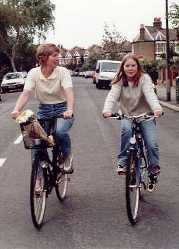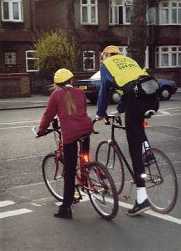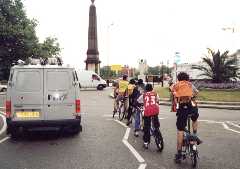
Good For You - Winter 2000
Cycling with Confidence
Vicky Carnegy puts parents minds at rest over children
and cycling
| You're worried. It's natural,
you're a parent after all. Your child wants to cycle, not just in
the park where you feel they are safe and secure, but on the road to school,
to their friends, to their clubs, everywhere. Yes, you know that
you should be encouraging them to get out and about rather than sitting
indoors in front of the computer but how do you help them to be safe and
sensible out there, especially since you can't even remember the last time
you sat on a bike?
Relax. Cycle Training Ltd is just one of a number of schemes around the country that can teach people how to use their bikes on the road. With a little help and advice you should be able to give your child the independence that they want without turning your own hair grey. But first see if your child's bike is still the right size and that everything is in working order before they go out on the road. If you are unsure about any adjustments then take it to a local bike shop where they will deal with everything from a simple puncture to a full service. |
 |
| Buying a bike
Go to a real bike shop rather than a supermarket or toy
shop. You will be able to choose from a range of both new and second hand
bikes and are more likely to get good advice.
|
 |
Equipment
Keep it simple. Other than a bike there is not much
else that you need.
If your child is to be cycling to school, fit a luggage
rack to the bike. Then they won’t have to carry a heavy school bag on their
back.
Gloves are useful in cold weather, as while the rest
of the body stays warm through pedalling the hands always seem to feel
the cold.
A rain jacket and possibly lightweight waterproof trousers
can be a good idea. These can be tucked away in a bag to be brought out
when necessary.
Shoes should have non-slip soles, so an ordinary pair
of trainers is fine.
Many cyclists wear fluorescent or reflective clothing.
This could be a jacket or a shoulder belt (a “Sam Brown” belt).
A helmet may help if your child should fall and hit their
head. If you get one make sure you buy it new and that it is marked
with one of these standards: BS EN 1078, SNELL, or ANSI Z 90.4. It must
fit snugly over the forehead and not move easily when tugged. Get help
in fitting from your bike shop.
| Training
This is the most important aspect to consider before your child starts cycling on the road. Children need to understand how roads work so they know what to do in all situations. If you are lucky your child's school will provide some training. This usually starts in primary school at years 5 & 6. Your Local Authority may also provide summer schemes so it is well worth contacting them. Schemes vary considerably in content so you should consider the following points. |
 |
Instructors should be enthusiastic, regular cyclists.
You wouldn't want your child to learn from someone who rarely uses a bike.
On-road training is important. Only by practising
on real roads can children learn how to cycle in traffic. Playground
exercises can start the process but are no substitute for the real thing.
The training has to be pitched at the right level.
Your child may be ready to cycle on quiet local roads but may need to practise
more before using main roads.
One-to-one training can be a real confidence boost, especially
if your child is taken over the journey that they need to practise, for
example, their journey to school.
Maintenance training. Your child should learn how to
check over their bike to make sure that it is roadworthy. There may even
be a separate bike fixing course that they can take.
With good training your child should soon be getting about confidently on their bike. Who knows, it may even inspire you to have a go!
Back to Quotes
| Contact:
Cycle Training 020 7564 5990 Main page | Principles| Individuals | Book a lesson | Families | Schools | Youth work | Employers | Consultation | Instructors |
 |